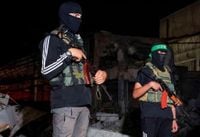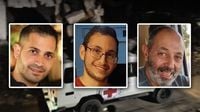In the tense aftermath of war in Gaza, the fragile ceasefire brokered by the United States has been tested by the slow, painful process of exchanging the bodies of hostages and prisoners between Israel and Hamas. The situation, as reported by multiple international outlets, remains fraught with logistical hurdles, political brinkmanship, and deep human suffering on all sides.
On October 15, 2025, President Donald Trump disclosed that Hamas is actively searching for deceased Israeli hostages throughout the devastated landscape of Gaza. Trump characterized the recovery operation as a "gruesome process," describing teams digging through collapsed structures and tunnel networks in search of remains. "They're finding a lot of bodies" under the rubble, he stated, emphasizing the challenge of identifying and separating bodies that "have been in there a long time" or are trapped beneath destroyed buildings (according to reporting from multiple sources including BBC and Reuters).
This recovery effort is a crucial component of the 20-point ceasefire agreement that Trump personally mediated between Israel and Hamas. While all living hostages have now been returned, the process of locating and repatriating the deceased continues, with both sides under intense scrutiny to uphold their ends of the bargain. Trump reiterated his demand for Hamas to completely disarm, warning that any failure to comply would prompt enforcement action. The president's comments reinforce the conditional nature of the current truce, which remains dependent on Hamas dismantling its military capabilities as outlined in the US-brokered agreement.
Hamas' armed wing, the Al-Qassam Brigades, announced on October 16 that recovering the remaining bodies of hostages requires substantial effort and specialized equipment. The group stated it has already handed over all living hostages and the bodies it managed to recover to date, and is currently exerting maximum effort to close this painful chapter. However, Hamas emphasized the challenging nature of locating and retrieving the remaining deceased hostages amid ongoing negotiations and recovery operations (as reported by Reuters).
The difficulties are not merely logistical. As noted by Dr. Martin Kear, a lecturer in international relations at the University of Sydney, "Hamas is absolutely correct in the fact that it says that it can't retrieve some of the bodies because... the overwhelming majority of these hostages are dead... because Israel has destroyed Gaza. And it's very possible that these hostages are buried under the rubble that's been created by Israel's destruction" (as reported by ABC News Australia). This grim reality has complicated the implementation of the ceasefire agreement and heightened tensions between the parties.
The process of exchanging bodies has exposed cracks in the peace process. On October 15, Hamas handed the remains of more hostages back to Israel, but the Israeli military stated that one recovered body was not that of a hostage. The remains of Tamir Nimrodi, Uriel Baruch, and Eitan Levi were sent from Gaza on Red Cross vehicles; another body returned was assessed as a Palestinian from Gaza. Israel, in turn, has been returning the remains of Palestinians to Gaza that had been withheld. These handovers are part of the ceasefire deal involving hostage and prisoner exchanges intended to end the war in Gaza, but delays in the recovery of Israeli remains have led Israel to withhold some humanitarian aid from Gaza (as reported by Haaretz and The New Arab).
Israel has made it clear that it expects Hamas to return all hostages—living or deceased—without compromise. Israeli government spokesperson Shosh Bedrosian stated, "We will not compromise on this, and we will spare no effort until our fallen hostages return, every last one of them." This hardline stance has been echoed by Israel's Defense Minister Israel Katz, who instructed the military to prepare a comprehensive plan to "defeat Hamas" in Gaza if the war is renewed, warning that if Hamas refuses to comply with the agreement, Israel will act to achieve a total defeat of the group (as reported by AFP and Reuters).
Meanwhile, the ceasefire’s implementation has been marred by violence and uncertainty. Reports indicate that Hamas has carried out executions of rivals in Gaza, seeking to reassert control over the enclave’s fractured security landscape. President Trump appeared unfazed by these incidents, stating that Hamas had been given approval to act as a temporary police force in Gaza. "Israel will return to those streets as soon as I say the word. If Israel could go in and knock the crap out of them, they'd do that," Trump told CNN, underscoring the precarious balance of the ceasefire and the readiness of both sides to return to conflict if the terms are not met.
As the Red Cross continues to facilitate the transfer of remains, confusion still lingers. On October 15, the bodies of Tamir Nimrodi, Eitan Levy, and Uriel Baruch were returned to Israel, along with another body believed to be a Palestinian from Gaza, according to Israeli media quoting a security official. Two more bodies were handed over to the Red Cross later that evening. Israel has threatened to stop the entry of vital aid into Gaza, citing the "slow" release of the bodies of Israeli captives. Despite these threats, Israel plans to open the Rafah crossing as originally scheduled in the ceasefire agreement, allowing for the delivery of food, medical supplies, and equipment needed for repairing damaged infrastructure (as reported by Kan and Al Jazeera).
The United States, for its part, is looking to establish a basic stabilization of Gaza, with planning underway for an international force to enter the Palestinian enclave. Countries such as Indonesia, the United Arab Emirates, Egypt, Qatar, and Azerbaijan have been mentioned as potential contributors to this force. Senior US advisers have stated that Hamas intends to honor the deal to return bodies, and that no Gazans would be forced to leave the enclave. However, US officials have also made it clear that no rebuilding money will go into areas still controlled by Hamas, focusing instead on "Hamas-free, terror-free zones" (as reported by Reuters and AFP).
On the ground, the humanitarian situation remains dire. Israel killed nine Palestinians attempting to return to their homes in Gaza City and Khan Younis on October 14 and 15, and at least 15 Palestinians have been shot and killed in areas near remaining Israeli troops since the ceasefire began, according to the UN Human Rights Office. Medical Aid for Palestinians has condemned Israel's restrictions on aid entry, calling it "outrageous" that life-saving humanitarian aid is used as a bargaining chip in negotiations.
As the ceasefire hangs in the balance, the fate of the remaining hostages—and the broader future of Gaza—remains uncertain. Both sides face mounting pressure to uphold their commitments, while the international community watches closely, aware that the smallest misstep could plunge the region back into violence. For the families of those still waiting for news, the wait is excruciating, and the hope for closure remains painfully elusive.

